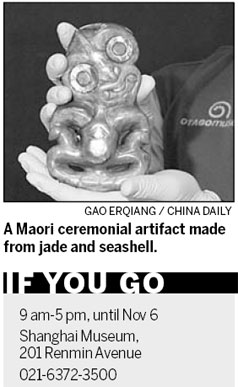Kia Ora, Shanghai ...
Updated: 2011-09-18 07:19
By Zhang Kun(China Daily)
|
|||||||
Shanghai

A Maori tribal chief guards the waharoa in the exhibition hall of the Shanghai Museum. He's been there since July 22 and he will stand by the carved gateway until Nov 6, uniting the spirits of the Maori treasures currently on exhibition.
This is the first time Maori art and culture has a dedicated exhibition in China. The Otago Museum from Dunedin, New Zealand, facilitated more than 300 artifacts on loan to Shanghai.
The museum also commissioned the waharoa made by Ngai Tahu craftsman James York. In doing this, Otago Museum wished to present the Maori as a living culture, rather than just an anachronism. After the exhibition ends, the gate will return to New Zealand as part of the Otago Museum's permanent collection.
Chen Kelun, vice-director of Shanghai Museum, says that once past the ceremonial gate, the space becomes part of Maori territory. He requested that "audiences please respect the Maori spiritual and cultural traditions, and not to take food or drink into the exhibition hall."
Researchers have found that the ancestors of Maori people came from Southeast Asia, especially Fu-jian and Taiwan provinces of China, thousands of years ago.
"There are lots of genetic similarity between the Chinese and Maori," Chen says. "And the cultures have much in common, especially the significance of jade."
Jade, known as "pounamu" or green stone by the Maori, plays a very important role in Maori culture. Known as a "taonga" (treasure), it is made into tools, ornaments and weapons, in particular adzes and hei-tiki (neck pendants). They are very cherished ornaments often passed down for generations. According to Maori folklore, Tiki was the name of the first human created by Tane, the Lord of the Forest.
"The Maori is one of three ancient civilizations that valued jade highly - the other two are the Chinese and the Maya in Mexico," Chen says.
This is the largest overseas show Otago Museum has mounted. Artifacts on display also include wood carvings, weapons, fishhooks, cloaks, music instruments and so on.
Popular exhibits include a waikaha made of whalebone, a racket-shaped weapon used for thrusting and striking in close-quarter fighting, as well as a cloak made from the feathers of kiwi birds.
Even the oldest of the exhibits is no more than 600 years, and many of them are from 300 to 500 years ago.
A team of Otago Museum specialists and representatives from the Maori Advisory Committee selected artifacts for exhibition, says Scott Reeves, a collection coordinator from Otago Museum.
Dunedin is a sister city of Shanghai, and in 2008, an exhibition of treasures from Shanghai Museum was successfully held at Otago Museum, coinciding with the opening of Dunedin's Chinese Gardens.
China Daily
(China Daily 09/18/2011 page15)